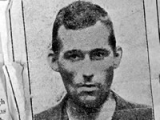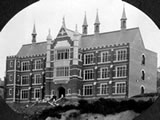What happened that day?
See historic events for any day of the year by entering the date below. Why not try your birthday?
Kiwi of the Week
Today in History

1911 Pawelka's last prison break
Joseph Pawelka escaped from Wellington's Terrace Gaol. It was the last in a series of bold but seemingly effortless prison escapes Pawelka made over an 18-month period.
Pawelka's first escape was from a prison in Palmerston North in which he was being held on theft charges. On 12 March 1910 he climbed over the wall with the assistance of two upturned buckets and an inattentive guard. He then rode off on a stolen bicycle. Two days later he was captured at Awahuri and taken to Wellington. On 23 March, after a short stay in the Terrace Gaol, he was transferred to police cells in Lambton Quay. He escaped again, this time assisted by the carelessness of Constable John Gallagher, who failed to lock the cell door after removing Pawelka's cell-mate.
Pawelka's suspected involvement in a series of robberies, burglaries and arsons as he fled north led to what was then New Zealand's biggest manhunt. One of the two constables involved in Pawelka's eventual recapture, at Ashhurst on 17 April, was none other than John Gallagher, no doubt redeeming himself for his inattention the previous month.
Following a series of Supreme Court trials, Pawelka was handed down a cumulative sentence of 21 years for theft, arson and escaping from custody. Members of the public saw the sentence as overly severe and organised protest meetings, committees and petitions in his favour. They were unsuccessful in persuading the government to intervene. Pawelka remained in the Terrace Gaol until he escaped by removing the grill from his cell window on 27 August 1911.
He was never recaptured. While family lore suggests he fled to Canada, in 1913 Truth gave an entertaining but possibly fictionalised account of his escape and new life in Mexico.
Image: Joseph Pawelka (Timeframes)

1904 Foundation stone for Victoria’s first building laid
Victoria College (now Victoria University of Wellington) was founded in 1897 to mark Queen Victoria's 60th jubilee year. In contrast to the strong physical presence the University has today, the College saw out its first few years with no permanent accommodation. The founding professors and early students had to make do with rented rooms at the Girls' High School in Pipitea Street and the Technical School in Victoria Street.
The eventual siting of the College in Kelburn was the result of an offer from wealthy Wairarapa sheep farmer Charles Pharazyn. In February 1901 Pharazyn offered to donate £1000 if the College was built on Kelburne Park Reserve, a 6-acre site. He claimed that his offer was an expression of his attachment to Wellington rather than the result of his large interest in the Kelburne Karori Tramway Company. The Company's cable car opened the following year and over the years has transported thousands of Victoria's students.
Governor Lord Plunket laid the foundation stone for the building in the presence ‘of a large number of ladies and gentlemen interested in the cause of higher education’. He also opened the building on its completion in 1906. It was eventually named the Hunter Building in 1959 in memory of Sir Thomas Hunter, the first Principal of the College. The building was restored and strengthened in 1992-3 and continues to be used today. The University is now spread over four campuses throughout the city.
Image: Hunter Building in 1908 (Timeframes)














